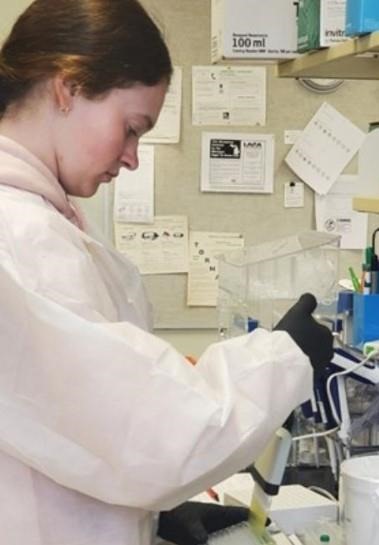
Umbilical cord structures of the calf.
Using a navel dip solution will prevent infections by killing pathogens and accelerating the drying process of the umbilical cord. The gold standard solution for navel dip is 7% tincture of iodine. Tinctures are alcohol-based solutions where the iodine provides the disinfectant properties and the alcohol serves as a drying action. However, due to restrictions on its use in the U.S., its availability can be limited. As an alternative, 2% chlorhexidine solutions can be used with similar efficacy. Iodine-based teat dips are not a substitute for the 7% tincture of iodine, it contains 1% or less iodine and skin conditioners such as glycerin that will slow down the drying process.
Navels need to be dipped immediately after the calf is born and Michigan State University Extension recommends a second application of the disinfectant within the first day of life, which can be done along with a second colostrum feeding. The correct way to apply is very important, and dipping is more effective than spraying. Cleanliness of the cup or container used to dip the solution is critical. A dirty cup can reduce the dip solution efficacy and spread infections. It is imperative to make sure that the entire navel is exposed to the solution, and for that, you can agitate the container pressing its edges to the skin around the navel's base.
Do not forget to monitor the calf’s navel through the first two weeks of life. The navel should be checked for excessive bleeding, pain, abnormal swelling, odor, or pus and treated as recommended by your herd veterinarian.
Step 2: Remove the newborn calf from the maternity pen
A clean maternity pen is critical for a successful newborn calf care program. However, the immediate removal of the calf from the maternity pen is essential to minimize or prevent the calf’s exposure to pathogens and prevent common calf infectious disorders such as navel infection, diarrhea, pneumonia and septicemia. Most newborn calves will stand by themselves within the first 30 minutes following birth, although some calves can take up to two hours. Once standing, the calf will attempt to nurse and, during the process, lick contaminated parts of the dam, dirty teats, and even the maternity facilities. Moving the calf to a designated and properly cleaned area is also an opportunity to quickly check its health status.
Step 3: Feed high-quality (Brix > 22) colostrum (10 % BW) within the first 6 hours after birth
Colostrum is the first mammary gland secretion produced by the dam after calving, and it is high in immunoglobulins (Ig), protein, energy and vitamins. Because there is minimal transfer of immunoglobulins from the dam to the calf during gestation, calf immunity relies on the immunoglobulins absorbed in the intestine during the first hours after birth. Therefore, failure to absorb the immunoglobulins from colostrum, known as the failure of passive transfer, will increase morbidity and mortality, reduce growth rates, and lower performance during productive life.
The success of the colostrum feeding management depends on the amount fed, the quality of the colostrum, and the timing, also known as the three Q's: Quantity, Quality, and Quickness of feeding colostrum. MSU Extension recommends feeding 10% of the body weight of high-quality colostrum, which consists of colostrum harvested hygienically and with high concentrations of immunoglobulins 50 g/L IgG’s (Brix > 22) within six hours after birth. Generally, Holstein calves will consume 4 quarts of colostrum during this time.
A recent study conducted by Desjardins-Morrissette and colleagues comparing tube and nipple bottle colostrum feeding observed no differences between those two methods regarding the IgG absorption. However, when feeding colostrum by nipple bottle, it is important to ensure that the correct amount of colostrum is consumed by the newborn calf. An esophageal tube feeder should be used if a calf cannot suckle from a bottle to consume enough colostrum. The cleanliness of the colostrum and the feeding supplies – including bottles, nipples, esophageal tubes – also play an essential role in the success of the colostrum feeding. Bacteria may interfere with IgG absorption across the gut, making it important to avoid contamination during colostrum harvesting, storage and feeding.
A second colostrum feeding within 6-12 hours after birth is highly recommended. When possible, we recommend an additional 2 to 3 quarts of clean colostrum, even if it is not high quality (less than 50 g/L IgG's, or under 22 on the BRIX scale). Some calves will not be hungry yet and refuse to suckle from the bottle. In this scenario, an esophageal tube feeder is warranted.
Source : msu.edu